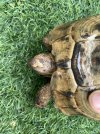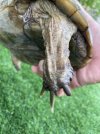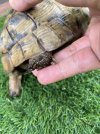deserttort
New Member
Hi folks, I adopted this beautiful lady a couple of months back. Appreciate your help on a few things:
Identification: have three Greek tortoises, but this doesn’t look anything like them; any guesses on breed and age?
The gash: There’s a big white scar running across her shell, but it is solid hard, and does not seem to be causing any problems. Any ideas of what this might be, and if I need to do anything special?
Diet: This poor thing only eats lettuce, and nothing else. No flowers, fruits, or anything else that my other fellows gobble up. I usually feed my torts arugula and other things that are approved by tortoise table. Any suggestions on how I can break her out of her bad habits? It’s been two months and nothing has worked.
Toes: I can’t shake the feeling like she has some missing digits. Does that seem like the case in the pics, and is there something I can / should do?
Thanks in advance!
Identification: have three Greek tortoises, but this doesn’t look anything like them; any guesses on breed and age?
The gash: There’s a big white scar running across her shell, but it is solid hard, and does not seem to be causing any problems. Any ideas of what this might be, and if I need to do anything special?
Diet: This poor thing only eats lettuce, and nothing else. No flowers, fruits, or anything else that my other fellows gobble up. I usually feed my torts arugula and other things that are approved by tortoise table. Any suggestions on how I can break her out of her bad habits? It’s been two months and nothing has worked.
Toes: I can’t shake the feeling like she has some missing digits. Does that seem like the case in the pics, and is there something I can / should do?
Thanks in advance!
Attachments
-
 C37E91C1-BF82-46CE-953C-DF5CDA67790E.jpeg2.3 MB · Views: 4
C37E91C1-BF82-46CE-953C-DF5CDA67790E.jpeg2.3 MB · Views: 4 -
 EB883827-A16E-465D-BA73-DA1AE7611D6B.jpeg2.1 MB · Views: 3
EB883827-A16E-465D-BA73-DA1AE7611D6B.jpeg2.1 MB · Views: 3 -
 DBB6CB91-9443-4889-A4DE-29C698FD14CC.jpeg2.1 MB · Views: 3
DBB6CB91-9443-4889-A4DE-29C698FD14CC.jpeg2.1 MB · Views: 3 -
 ED72E855-2523-4624-821A-E5A634DF524D.jpeg2.3 MB · Views: 3
ED72E855-2523-4624-821A-E5A634DF524D.jpeg2.3 MB · Views: 3 -
 AB6381C5-728D-4224-AF99-E7FF587276FF.jpeg1.8 MB · Views: 5
AB6381C5-728D-4224-AF99-E7FF587276FF.jpeg1.8 MB · Views: 5 -
 4D251B87-75F2-4027-B0B3-2F2F87B7E4E7.jpeg2.1 MB · Views: 4
4D251B87-75F2-4027-B0B3-2F2F87B7E4E7.jpeg2.1 MB · Views: 4 -
 A21CD1B9-CD90-4E39-83D1-6FB40D4E0ABC.jpeg1.7 MB · Views: 4
A21CD1B9-CD90-4E39-83D1-6FB40D4E0ABC.jpeg1.7 MB · Views: 4 -
 CDA078BD-4E06-4540-B39D-5FD457635E62.jpeg2.5 MB · Views: 5
CDA078BD-4E06-4540-B39D-5FD457635E62.jpeg2.5 MB · Views: 5 -
 A48063AF-21EC-40AD-AD64-C5977C913CF5.jpeg1.8 MB · Views: 4
A48063AF-21EC-40AD-AD64-C5977C913CF5.jpeg1.8 MB · Views: 4 -
 B795B073-D9EB-498D-A768-BCC8D227451C.jpeg1.3 MB · Views: 4
B795B073-D9EB-498D-A768-BCC8D227451C.jpeg1.3 MB · Views: 4 -
 5FDF5133-D626-4330-BE9F-9A248EB638EA.jpeg1.8 MB · Views: 4
5FDF5133-D626-4330-BE9F-9A248EB638EA.jpeg1.8 MB · Views: 4 -
 5C8A8074-FAC5-45B8-BF5B-946E78504D7B.jpeg1.5 MB · Views: 4
5C8A8074-FAC5-45B8-BF5B-946E78504D7B.jpeg1.5 MB · Views: 4 -
 873284D8-9263-4E7E-8F2C-2B2ACAC531D2.jpeg1.8 MB · Views: 4
873284D8-9263-4E7E-8F2C-2B2ACAC531D2.jpeg1.8 MB · Views: 4
